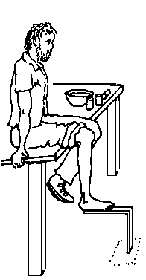|
> 3000 Ave Marias -- Songs of Sharon -- Remi Ghesquiere -- St-Basil's Hymnal -- PROJIMO -- Beyond Good and Evil |
|
104
|
|

A GOOD SOLUTION FOR EASIER CASTING. In February, 1996, I (the author) had surgery on my foot, to fuse my ankle bones. The cast was changed in 2 weeks. To position it correctly, the surgeon put my foot on a flat metal bar in the form of an up-side-down "L", which was mounted in the cement floor. He placed my foot and leg in exactly the desired position and asked me not to move. He wrapped a plaster bandage around my lower leg and foot, also covering the flat bar under the foot. When the plaster was fairly hard, he slipped the casted foot backwards off the bar. Then he gently pressed the plaster on the bottom of the foot to close the slit that was left from the bar. With this simple device, the foot can be positioned correctly and held
firmly during casting, without the hands of an assistant getting in the
way. When I was next at PROJIMO, I described this innovation to the team.
Marcelo and Polo began to make one right away.
Rather than mounting the device in the floor, they decided to mount it in a rectangular slab of cement so that it could be moved from place to place. To make the bar, they used a 1.5-inch-wide steel strut that they found in the wheelchair shop. This they hammered into a "U". On one arm of the U, they welded cross-bars of re-bar (construction rod) so that it would be held firmly within the cement base. Then they made a 2-inch high rectangular wooden frame. They set the steel-bar U within it, and then filled it with cement. TERE was the first person to have a foot casted with the new device. She is a young women whose spastic foot pushes downward and sideways when she tries to stand on it. She needed a strong below-the-knee plastic brace to keep her foot flat on the ground, and to push her knee back, while standing. (She was just beginning to stand using parallel bars. See page 208.)
|
| ||||||||||||||||||||||||||||||